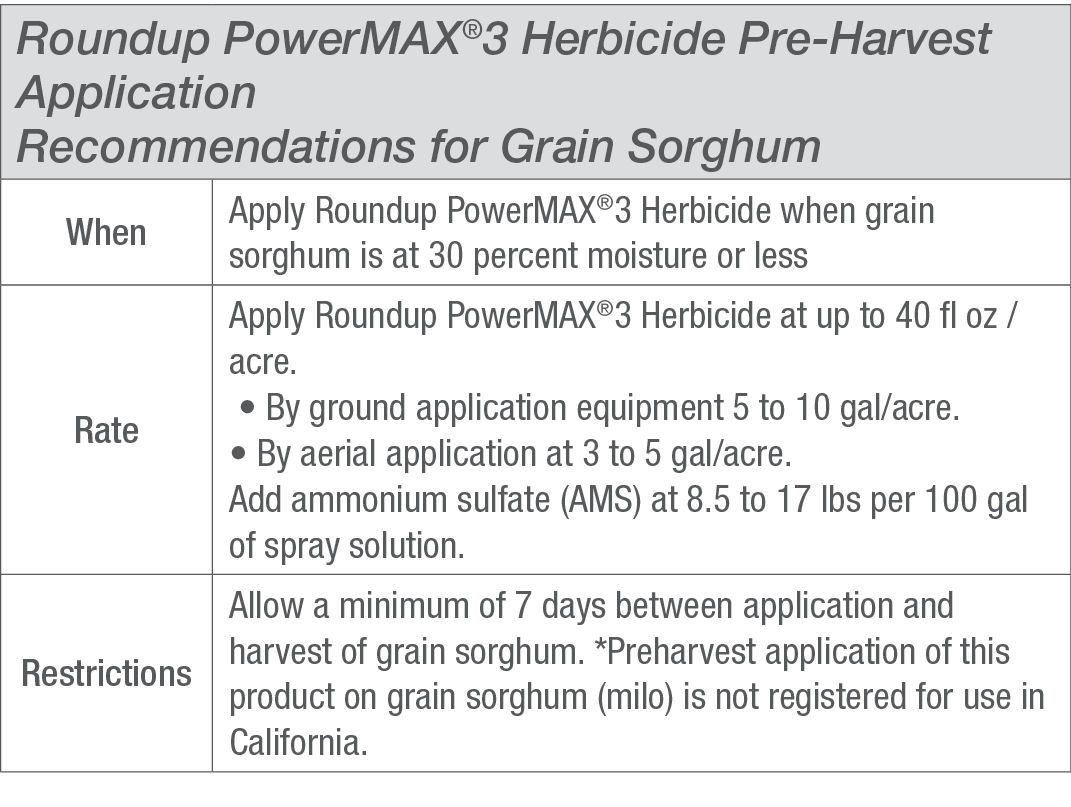Pre-Harvest Roundup PowerMAX® 3 Herbicide Applications on Grain Sorghum
June 28, 2023
Introduction
Grain sorghum producers have a preharvest option to use a PowerMAX® 3 Herbicide application to help allow an earlier harvest which has many advantages.
- Desiccation of foliage can allow for earlier harvest.
- May reduce grain moisture at harvest.
- Dry out the late-emerging nonproductive suckers or tillers that could delay harvest.
- Less green matter at harvest which can increase harvest efficiency.
- Late-season weed control can help reduce late-season weed seed production.
- Late-season water uptake from the sorghum and weeds may be reduced, resulting in more soil moisture for the next crop.1
A pre-harvest herbicide application after maturity, to help dry down a grain sorghum crop, is often more important with this crop than other annual grain crops because grain sorghum is a perennial species. After producing seed, the plant remains green and alive until killed by an herbicide application, tillage, or freezing temperatures. Grain is often slow drying, and harvest is often delayed until late fall, delaying rotation to a winter crop such as wheat. Harvest delays can also increase harvest losses due to damage caused by wind, snow, and birds.2
Application Restrictions
Roundup PowerMAX® 3 Herbicide should not be used pre-harvest on sorghum grown for seed, as reduction in germination or vigor may occur. After an application of Roundup PowerMAX® 3 Herbicide, sorghum should not be harvested for a minimum of seven days, and it may take from two to three weeks for the herbicide to completely kill the sorghum plant. When applying Roundup PowerMAX® 3 Herbicide pre-harvest, if grain sorghum is drought-stressed, diseased, or lush due to irrigation, it is recommended to increase the application towards the higher end of the labeled herbicide rate and add a full rate of AMS (17 lbs/ 100 gal of spray solution). Avoid a pre-harvest application of Roundup PowerMAX® 3 Herbicide if sorghum is infected with charcoal rot as lodging may occur. If a pre-harvest application is made for an earlier and more efficient harvest it is important that the crop be harvested in a timely manner. Only spray what can be harvested in several weeks after the seven days post application period.

Always read and follow the herbicide label directions.

Always check for crop maturity by inspecting the grain positioned on the lower part of the head as grain sorghum will bloom and then mature at the top of the head first. The seed located on the bottom of the head is the last to reach black layer maturity. At black layer the grain should be around 25% to 30% moisture.
Harvest aids and yield response
Harvest aids have no effect on yield response, for the growing crop, as the grain has reached black layer, which is physiological maturity. At this stage of growth, the total yield production for this crop has been set and crop dry-down is the only plant response expected from an application at this time. The advantages of a preharvest herbicide application are associated with a timely harvest and yield preservation which can reduce crop losses due to lodging which can be caused by adverse weather or disease. Another advantage is by using an herbicide to kill the plant after grain maturity, but before a killing frost has killed the sorghum plant, can reduce the plant’s ability to use additional moisture from the soil profile. This will allow the next crop to utilize that additional moisture for plant development which can have a critical yield response for the following crop, often seen in a dryland production system. Moisture can also be conserved for a following crop by using an herbicide to kill any green weeds still growing after the crop has reached physiological maturity, again which can be important for the following crop in a dry-land production system.
Sources
1 Fromme, D., Stephenson, D. O. and Price, P. P. III, 2017. Utilizing Harvest Aids in Grain Sorghum. LSU AgCenter. Research-Extension-Teaching. https://www.lsuagcenter.com/profiles/aiverson/articles/page1503673878799.
2 1998. Grain Sorghum Production Handbook. Kansas State University Agricultural Experiment Station and Cooperative - Bookstore. https://bookstore.ksre.ksu.edu/Item.aspx?catId=281&pubId=158.
2126_224128